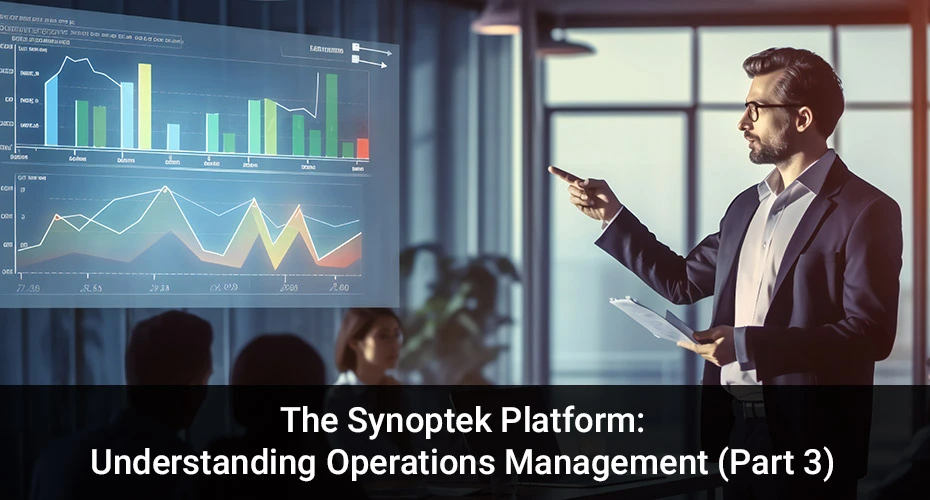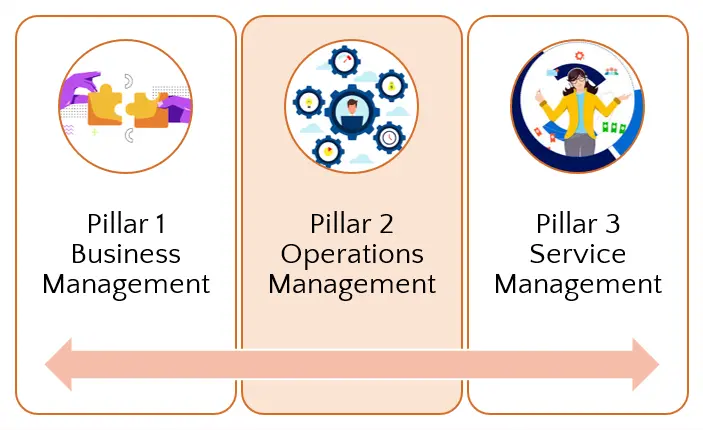February 29, 2024 - by Synoptek
Every organization today that relies on technology seeks to drive the best outcomes from its technology investments. At the same time, it also looks to meet business needs while limiting implementation and ongoing operational costs. A robust IT Service Management framework can drive the right economies of scale and deliver higher value.
In the second part of our 5-part blog series, we dove into the Business Management pillar of the Synoptek Platform. This third part will delve into the second pillar of the Synoptek Platform, aka Operations Management.

What is Operations Management?
Operations management can be defined as the strategic planning and implementation of processes aimed at optimizing the flow of information and productivity within an organization. Think of an operations manager in a factory; their role is to analyze resources, equipment, and workforce to meticulously devise and execute processes that ensure the timely delivery of a company’s products or services to its customers.
IT Service Management Pillar 2: Operations Management
Rapidly changing technology, growing security and scalability issues, and poor visibility make IT Operations Management challenging. To operate at peak efficiency, every organization must streamline day-to-day operations. The second pillar of the Synoptek Platform is Operations Management. As a subset of IT Service Management, Operations Management focuses on maintaining technology infrastructure, devices, components, and applications.
This second pillar of the Synoptek Platform offers a strong foundation for businesses to manage their IT operations efficiently and cost-effectively. It helps minimize incident management costs, improve security and compliance, and increase productivity. Regularly assessing, analyzing, and monitoring ensures that IT systems are safe, dependable, and meet industry rules and standards. All these benefits, in turn, help us improve customer service and satisfaction levels.

The Key Components of Operations Management
The Operations Management pillar of the Synoptek Platform simplifies processes and reduces manual work, enabling businesses to prioritize productive tasks. It improves daily IT operations, guaranteeing continuous system availability and creating a basis for expansion.
We define a set of policies and procedures that encompass network, helpdesk, and endpoint management. These policies help us forecast and prevent issues, reduce system downtime, and minimize user impact.
Here are the key elements of Operations Management:
Customer Capability Benchmarking
Every organization is different, with unique IT needs. To enable efficient technology operations, Synoptek first measures every customer’s overall IT service delivery operational maturity. It does this by benchmarking existing capabilities against Synoptek’s standard IT maturity model.
It tracks and reports on IT maturity progress and allows customers to report on overall IT maturity improvement. In addition, Synoptek conducts an annual customer technology management and capability benchmark. This showcases where the customer falls in the spectrum of IT utilization and enables compelling business results accordingly.
Security and Access Management
Synoptek leverages a standard portfolio of compliance and security processes across all practice areas to enable the highest levels of security. It deploys a standard set of access control and security processes for each customer, including antivirus and malware.
We recommend that our customers employ Multifactor Authentication (MFA) for all private network and critical application access. We also suggest following the least-privileged access protocol. In addition, customers have the option to adopt and consume additional security services from Synoptek’s Cybersecurity practice.
Workflow Automation
Synoptek leverages enterprise-grade workflow and automation engines to automate IT Service Management processes that may be laborious and challenging for customers. Using our team of dedicated experts, we expand the use of automation technologies to improve service quality and execution.
Standard automated processes include incident management, service request management, change management, and problem management. We create custom workflows for new employee onboarding, role changes, and termination to account for customers’ specific requirements. These workflows enable the consistent execution of standard processes and procedures.
IT Operations Analytics
Analytics is an integral part of any IT Service Management framework. We collect data from systems that manage our customers’ infrastructure using the Synoptek platform. It aggregates that data into a data warehouse and delivers predictive analytics.
By recommending proactive actions to prevent incidents and improve systems capabilities, it helps improve operational outcomes. Such analytics also helps identify recurring issues (or problems), replacement needs, upgrade needs, and other problem areas.
Monitoring and Enterprise Operations Center
Synoptek deploys several monitoring solutions to all the devices, systems, and applications we manage. We maintain two geographically redundant enterprise operations centers (EOC) that consistently watch our monitoring systems globally and triage alerts continuously.
Our EOCs act as the first line of defense against potential business disruptions. They allow us to monitor, remediate, and resolve alerts within pre-defined SLAs. If an alert is not resolved within a few minutes, it is automatically allocated to the right team for further investigation and resolution.
Fuel IT Operational Excellence with the Synoptek Platform
In this digital age, strategically managing an organization’s information technology (IT) needs is crucial. The Synoptek Platform streamlines the managing, planning, and provisioning of IT resources, digital services, networking, and other IT infrastructure. Through effective IT operations management, it ensures the availability, efficiency, and performance of the organization’s processes and services – thereby improving the end-user experience.
In the fourth part of this 5-part series, we will walk you through the third and last pillar of the Synoptek Platform – Service Management.
